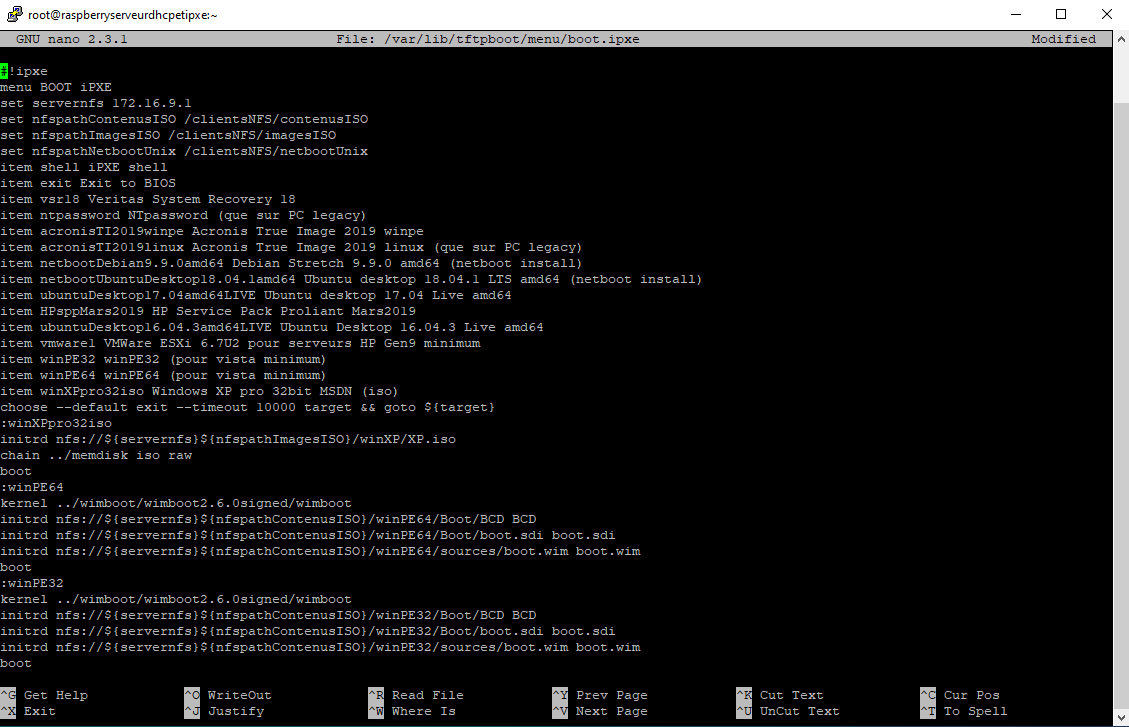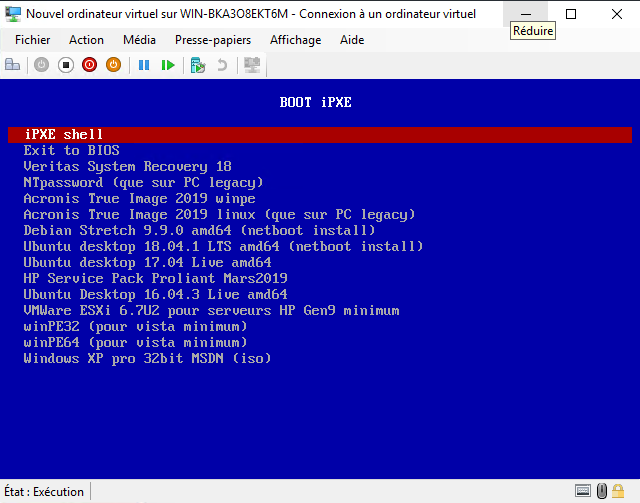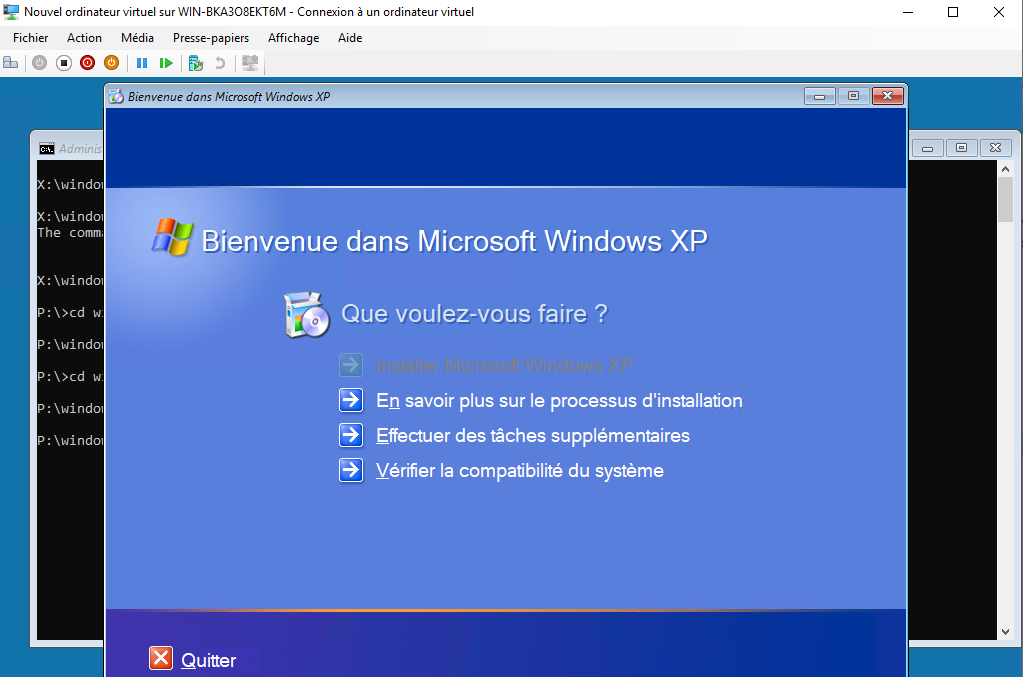boot iso XP legacy
-
Hi all !
I have a problem to boot Windows XP isos on computers in legacy mode with ipxe. I have an error message: memdisk bootstrap too large to load.
No problem with other installations with wim files.
Can you help me?
Thank you! -
How much memory is available on this old Windows XP’s machine?
What version of FOG are you using?
Of note, RAM disk size was updated in 1.5 to use 275000 kilobytes, or about 270 MB minimum. I am guessing this machine has around 256 or less memory?
-
How much ram is in this computer vs the size of the iso image. Using memdisk it transfers the entire content of the iso image into memory and then executes the iso image in memory. I’d have to dig out my old copies of XP to see how big the iso image is. But this could be your first limitation.
-
i don’t use fog, i use ipxe.
The machine has 4GB -
@bluedark memdisk is a 32 bit application the maximum size of the iso image is 2GB in size. What size is the iso image you are trying to boot? With a target computer there is enough ram to run this iso image as long as it fits into a 32bit address space.
-
While we don’t mind helping people out, this is a forum for FOG, not for iPXE. While we use iPXE in our application, we do not have all the answers for it.
-
@george1421 Oh ok. Indeed, the iso is more than 2GB. So, how to do?
-
@bluedark Understand XP is so 2002, but you might be able to use a process that I worked out for netbooting windows 7. That is what you are booting is a winPE image that connects to a windows file share that has the installer files (the content of your iso image) on and run setup from there.
-
The idea I’m thinking of is based on this post: https://forums.fogproject.org/post/103323
It shows you how to copy the image to a FOG server (a windows server will work here too). If you use the FOG server you will need to install and configure SAMBA because winpe only speaks CIFS. ref: https://forums.fogproject.org/post/103318
The instructions show you how to build the winpe boot image using windows WAIK.
And finally it shows you how to create the menu entry for memdisk. Since this winpe boot image is about 300MB there is no problem using memdisk to launch winpe which then connects to the network CIFS file share and run the windows setup program.
-
@george1421 yes it’s already what I use and it works until Vista. But for XP, when I run the setup from winPE (32bit), the first line “install Windows XP” is greyed out and I don’t understand why.
-
@bluedark Now I’m just guessing, but it may be that winpe is the problem since it is a 32 bit application, and XP is looking for a 16 bit dos environment to install. Boy this is stretching way back. WFWG / LAN Manager boot disk (that can also be dispatched via FOG).
Or see what you can hack out of the iso image to get it below 2GB.
-
@george1421 in fact, i said nonsense, my iso is much less than 2gb. What is WFWG? thank you !
-
@bluedark WFWG is Windows for workgroups. It predates windows 95.
Well if its less than 2GB we need to rethink this error.
-
@george1421 What does you iPXE menu look like. Can you show me a screen shot of the web ui configuration page?
Also what version of FOG are you using? I understand you are not using fog for imaging but that may also give us a clue. I have had someone post FOG is not working and they were using 0.30 version of fog (hint 10 years old version).
-
Thinking back here. We are talking about XP, so that means no nvme, uefi, sata raid, (I’d question ahci disk mode too). I also seem to recall if the target disk had files on it it wouldn’t go through the install XP path, but you had to upgrade path. So assuming the hardware can meet the other requirements of XP make sure there are no partitions on the target hard drive. You still might need the F6 disk drivers so XP can see the disk adapter.
I’m just thinking of reasons why it won’t work. (the remote xp setup mode that is)
-
@george1421 thank you very much for your reply.
In fact, I don’t see concretely what is FOG used for compared to ipxe?
Currently I have my ipxe which is on my dhcp server and which will look for the installations which are on my nfs server.
I don’t have a web user interface.
Here my ipxe config (sorry in french) :
UI on boot pxe :
And my problem setup XP on winPE :
-
@bluedark OK I see the issue I was having. You said a few things that didn’t link with the way FOG works. I was under the impression you were using FOG as a netboot server as outlined in this tutorial: https://forums.fogproject.org/topic/10944/using-fog-to-pxe-boot-into-your-favorite-installer-images
FOG is a disk imaging tool, where you create a golden/master/mother image on a computer, then capture that image with FOG and deploy that image to many computers. FOG is built on top of other open source projects like iPXE, ISC-DHCP, rEFInd, etc. Within FOG’s web ui there is a utility that FOG Admins can create custom iPXE menus to do other things (like netbooting) that is not related to FOG imaging. I had the impression you where reusing FOG for netbooting and not for imaging as it was designed.
I can offer you a few tips with your ipxe menu. From what I can see of the screen shot of the ipxe menu your winpe entries will (should) only boot under bios, for uefi booting you need to use the -n command switch as in this post: https://forums.fogproject.org/post/103331
Remember you can use different protocols for netbooting beyond nfs. You can use http which is very scalable and fast protocol.
You are running winsetup on your winpe instance. Can winPE see the target disk?
Can you run diskpart from winpe and remove all partitions on the target computer?
What target hardware are you trying to install XP on?
-
@george1421 no need for the -n switch, the winpe boot in legacy as well as uefi.
I can see the disk and partitions from winPE (verified with diskpart).
I do a clean on the disk.
I try to install XP in pxe from several different workstations and I also test on hyper-v virtual machines.
Always the same problem… -
Exactly how large is the ISO, how much memory is available to the machines you’re trying to load the ISO from?
If the ISO is 2GB for example, then you need at least 2GB of RAM for the ISO to load to the machine.
-
@Tom-Elliott the iso is 600MB and the machines are 4GB